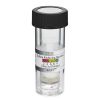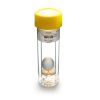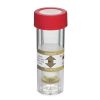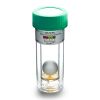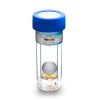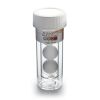Hach Denitrifying Bacteria BART Test
Features
- Simple yet effective method for monitoring the population size and/or activity of specific groups of bacteria
- Easy to use, requiring no elaborate or costly equipment and no specialized training
- Effective and affordable tests are easy to interpret and can be performed at room temperature in virtually any environment
- Free ground shipping
- Expedited repair and warranty service
- Lifetime technical support
- More
Overview
The Hach Denitrifying Bacteria BART Test identifies the presence and activity of various bacteria. If highly aggressive bacteria are detected, the water should be tested for the presence of coliform bacteria.
Applications
Denitrifying bacteria indicate the decomposition of waste organic nitrogenous materials. These bacteria reduce nitrate to nitrite, and some continue nitrification to gaseous nitrogen (complete denitrification). In water, aggressive denitrifiers can indicate high concentrations of nitrates and that the sample is probably anaerobic and relatively rich in organic matter. The presence of denitrifying bacteria can indicate that the water has been polluted by nitrogen-rich organics from sources such as compromised septic tanks, sewage systems, industrial and hazardous waste sites.
In The News
Source Water Monitoring in Albany, New York: Tracing Water Quality throughout Tributaries
Thousands of US cities pull their drinking water from natural source waters like reservoirs, rivers, and streams, making overall watershed health a key consideration for water providers. In Albany, New York, the Albany Department of Water and Water Supply delivers drinking water to over 100,000 residents as well as monitors and manages the larger drinking water supply watershed. Hannah Doherty, Environmental Specialist at the Albany Department of Water and Water Supply , spends her days working with a small team to monitor the drinking supply and the connected water bodies. Doherty explains, “We’re the first to encounter the water that ends up being the drinking water.
Read MoreWildfire Prevention in the Sierra Nevada Region with the Yuba Watershed Institute
Though recent wildfires have sparked new conversations about wildfire management and response, groups like the Yuba Watershed Institute have been monitoring the forests and water resources of the Sierra Nevada region for decades, managing approximately 5,000 acres of land with the Bureau of Land Management (BLM) and about 7,000 acres in private land partnerships. The goal of the Institute is to work with local communities and land agencies to improve watershed and forestry management through informed practices and public outreach. The goals of the Yuba Watershed Institute are three-fold: Improve the ability of fire suppression agencies like the California Department of Forestry and Fire Protection ( CAL FIRE ) and the US Forest Service.
Read MoreWave Sensors Integration with NexSens Buoys: A Cutting-Edge Solution for Wave Measurment
Real-time wave data supports accurate weather prediction, safe and efficient maritime operations, and provides valuable safety and operating condition information for recreation and commercial fishing. Understanding wave dynamics also helps with the design of protective coastal structures like seawalls, breakwaters, and jetties. It also supports better prediction of their impact on sediment transport and coastal geomorphology. Wave data is a key factor in qualifying and designing offshore wind farms and harnessing kinetic energy for electrical generation. It helps with the understanding of ocean-atmosphere interactions and contributes to studies of sea-level rise and climate change impacts.
Read More


